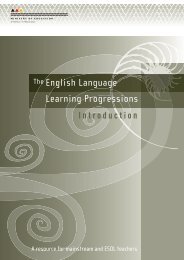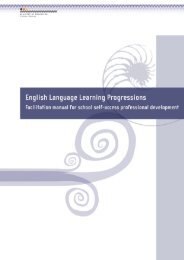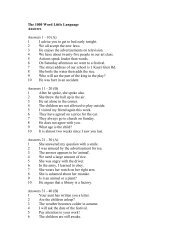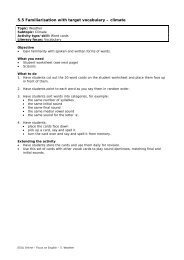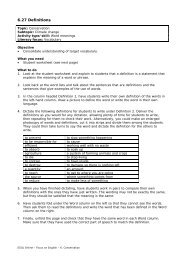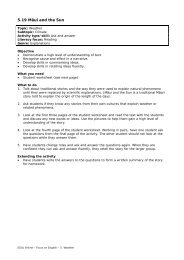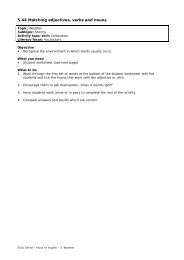ELLP Years1-4 - ESOL - Literacy Online - Te Kete Ipurangi
ELLP Years1-4 - ESOL - Literacy Online - Te Kete Ipurangi
ELLP Years1-4 - ESOL - Literacy Online - Te Kete Ipurangi
Create successful ePaper yourself
Turn your PDF publications into a flip-book with our unique Google optimized e-Paper software.
A learner’s level of<br />
literacy in their first<br />
language strongly<br />
influences their<br />
rate of progress in<br />
reading in English.<br />
Judgments about<br />
progress can only be<br />
made over time and<br />
based on a variety of<br />
assessment methods.<br />
Factors affecting progress<br />
English language learners develop proficiency in reading at very different rates. There are<br />
many factors that affect the starting point for learners and that have a strong influence on<br />
their rates of progress. Perhaps the most important factor, especially for learners beyond<br />
the first two or three years of schooling, is the level of literacy that they have attained in<br />
their first language. Learners who have had no previous formal education and who can’t<br />
read or write in their first language will take much longer to learn written English than<br />
learners who are literate in their first language. The older an English language learner<br />
is when they begin schooling, the greater and more noticeable the gap will be between<br />
them and their native-speaker peers and the greater their need will be for intensive,<br />
long-term support.<br />
Assessing and reporting on reading<br />
The primary purpose of assessment is to improve students’ learning and teachers’<br />
teaching. By focusing on giving useful feedback (a key component of formative<br />
assessment) throughout the learning process, teachers can work with their English<br />
language learners to close the gap between their current performance and what is<br />
expected of their native-speaker peers. A teacher can assess and report on a learner’s<br />
progress in reading by using standardised tests conducted at regular intervals and by<br />
making informal judgments about the learner’s comprehension of reading texts at<br />
different levels of complexity. It’s unwise to make broad judgments about “reading ages”<br />
or “reading levels” based on the occasional use of a reading assessment tool. Reading<br />
proficiency is influenced by many factors (such as the learner’s familiarity with the<br />
content of the texts, the cultural knowledge required to understand the texts, the quality<br />
of the teacher’s scaffolding, and the learner’s motivation). A single assessment provides<br />
only a snapshot of a learner’s proficiency in relation to the task at the time, although it<br />
may also indicate areas of strength and weakness in reading.<br />
Making decisions about a learner’s progress is complex because it requires ongoing<br />
diagnostic assessment to gain information about what a learner needs, integrated<br />
with summative assessments that define a point the learner has reached. Assessment<br />
of reading development should include making informal observations about the<br />
learner’s attitudes and approaches to both extensive reading and reading for deeper<br />
understanding, how much reading they are doing, their ability to choose appropriate<br />
reading materials for different purposes, and their awareness of reading strategies. For<br />
further information on reading assessment, see the <strong>ESOL</strong> Progress Assessment Guidelines.<br />
16





